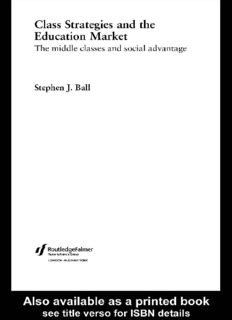
Class Strategies and the Education Market: The Middle Classes and Social Advantage PDF
Preview Class Strategies and the Education Market: The Middle Classes and Social Advantage
Class Strategies and the Education Market Modern state education was essentially formed around the needs and interests of the middle class. The middle classes are currently very much at the centre of all politicians’ electoral concerns. Nevertheless sociological and educa- tional research has tended to neglect the middle class. Class Strategies and the Education Marketexamines the ways in which the middle classes main- tain and improve their social advantages in and through education. Drawing on an extensive series of interviews with parents and children, this book identifies key moments of decision-making in the construction of the educational trajectories of middle-class children. Stephen J. Ball organizes his analysis around the key concepts of social closure, social capital, values and principles and risk, while bringing a broad range of up-to-date socio- logical theory to bear upon his subject. From this thorough analysis, valuable and thought-provoking insights into the assiduous care and con- siderable effort and expenditure, which go into ensuring the educational success of the middle-class child, emerge. The middle classes are a sociological enigma, presenting the social researcher with considerable analytic and theoretical difficulties. Class Strategies and the Education Market provides a set of working tools for class analysis and the examination of class practices. Above all, it offers new ways of thinking about class theory and the relationships between classes in late modern society. Stephen J. Ball is Karl Mannheim Professor of Sociology of Education and Director of the Education Policy Research Unit at the Institute of Education, University of London. Class Strategies and the Education Market The middle classes and social advantage Stephen J. Ball First published 2003 by RoutledgeFalmer 11 New Fetter Lane, London EC4P 4EE Simultaneously published in the USA and Canada by RoutledgeFalmer 29 West 35th Street, New York, NY 10001 This edition published in the Taylor & Francis e-Library, 2003. RoutledgeFalmer is an imprint of the Taylor & Francis Group 2003 Stephen J. Ball All rights reserved. No part of this book may be reprinted or reproduced or utilised in any form or by any electronic, mechanical, or other means, now known or hereafter invented, including photocopying and recording, or in any information storage or retrieval system, without permission in writing from the publishers. British Library Cataloguing in Publication Data A catalogue record for this book is available from the British Library Library in Congress Cataloging-in-Publication Data A catalog record for this book has been requested ISBN 0-203-21895-7 Master e-book ISBN ISBN 0-203-27422-9 (Adobe eReader Format) ISBN 0-415-27277-7 (pbk) ISBN 0-415-27276-9 (hbk) For John Ball 1381/1994 When Adam delved and Eve span Who was then a gentleman? From The Peasant’s Revolt of 1381 Contents List of illustrations viii Acknowledgements ix 1 Introduction: between structure and hermeneutics 1 2 Class and strategy 14 3 Class and policy 25 4 Social class as social closure: a strategic approach 53 5 Social capital, social class and choice 79 6 Values and principles: social justice in the head 111 7 Risk, uncertainty and fear 148 8 Class practices and inequality 167 Appendix I 181 Appendix II 188 Notes 189 Bibliography 194 Index 211 Illustrations Figures 1.1 Structure, class and state: an analytical framework for education policy and practices 9 6.1 An heuristic map of choice of school 118 Tables 2.1 Three levels of analysis as a unified system 19 6.1 Parents’ employment and choice of school 136 6.2 Parents’ schooling and choice of school 136 A1.1 Parents’ occupational sector (school choice sample) 186 A1.2 Parents’ education (school choice sample) 186 A1.3 Parents’ employment (school choice sample) 187 A1.4 Parents’ occupational sector (higher education sample) 187 A1.5 Parents’ employment (higher education sample) 187 Acknowledgements A lot of people have helped me with this book, in many different ways. Most important among them is Trinidad without whom it would never have got started and would certainly not have been finished – I cannot say enough. Richard Bowe, Miki David, Jackie Davies, Sharon Gewirtz, Sheila Macrae, Meg Maguire, Diane Reay and Carol Vincent were the main pro- tagonists in fieldwork and interviewing and many extracts from interviews they conducted are quoted in the text. Agnes van Zanten commented on chapters and the work we did together on several comparisons of education in England and France was very useful to me. Carol Vincent had the patience and stamina to read and comment on everything, for which I am very grateful. Harry Brighouse and Alan Cribb undertook my philosophical education and made me think differently, especially about Chapter 6. Meg Maguire gave me the usual hard time, especially over Chapter 8. Val Hey, Hugh Lauder, Philip Noden and Tim Butler also read parts of the book. Jim Scheurich fed me relevant research from the US. Thank you to Caroline Gill for her multi-tasking and Anjali Kothari who made the diagrams for me. I also thank Annie and Rebecca for helping me cope and Geraldine for the house. Whatever weaknesses remain are down to me.
Description: